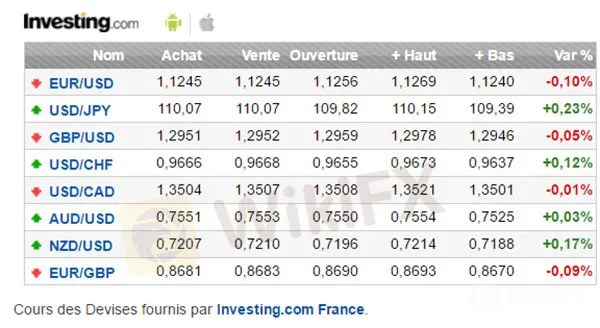简体中文
繁體中文
English
Pусский
日本語
ภาษาไทย
Tiếng Việt
Bahasa Indonesia
Español
हिन्दी
Filippiiniläinen
Français
Deutsch
Português
Türkçe
한국어
العربية
How Do Currency Pairs Work in the Forex Market?
Abstract:If you want to trade currency pairs in the forex market, you are spoiled for choice. But to trade properly, you have to understand how it works, especially when it comes to price charts. And that's what we're going to see today.
EUR/USD, USD/JPY, EUR/CHF…If you want to trade currency pairs in the forex market, you are spoiled for choice.
But to trade properly, you have to understand how it works, especially when it comes to price charts. And that's what we're going to see today.
Currency pairs: the basics
There are two things to know about currency pairs.
The first one is that as their name tells, they always come in pairs. It makes sense: If you want to get a quotation, you will have to compare one currency to another.
One Euro will always be one Euro for you. But in itself, it has no real value. In the United States, your Euro is worth nothing (that means you cannot buy anything with it), unless you exchange it for some US Dollars: here is its true value. In fact, your Euro is not worth one Euro but X Dollars in the United States.
Its the same in the forex.
And depending on the quotation of the moment, with this Euro you can buy more or less US Dollars (Reminder: the quotations change constantly).
From this comparison was born the quotation of the EUR/USD pair (surely it works the same way for all pairs) that youve found:

The second thing to know is that on the forex spot, these pairs are always defined in the same order.
For example, the USD/JPY pair will always have the US Dollar firstly and the Yen secondly. Never in the opposite way (the JPY/USD pair does not exist).
It's a convention. And all forex investors in the world have access to the same currency pairs like you and of course, the same charts.
How do currency pair charts work?
1. The supply/demand mechanism:
Let's take the example of the EUR/USD pair again:
As I told you, the quotation will always be based on “how many US dollars are equal to one Euro?”.
On the chart, the figures on the right side correspond to the value of one Euro in Dollars:

In every market, there is a supply/demand mechanism which varies the price curve of the EUR/USD pair:
- If market operators are less interested in the Euro, there will be more supply than demand. And then, the price of the Euro against the Dollar drops (you will get fewer Dollars by one Euro).
- If market operators are very interested in the Euro, there will be more demand than supply. And then, the price of the Euro against the Dollar increases (you can get more Dollars by one Euro).
2. Common mistake: dissociate mentally the 2 currencies of the pair
You may think, “Okay, but I just want to buy some Dollars.” For that, I have to position myself at the purchase side on the chart, right? No. This is a very common take of misconception.
It has already been given that you can't “buy some Dollars only” and the price curve represents the Euro against the Dollar (in that case, the Euro is the main currency of the pair) but not the Dollar against the Euro.
Therefore, for “buying some Dollars”, you have no other choice but to sell Euros.
And for selling Euros, you have no other choice but to position yourself at the selling side on the EUR/USD chart.
It works in the same way for the opposite direction.
Don't make the mistake of separating two currencies: by their nature, they go in pairs. Each pair is a “whole” and it is the quotation of the pair that is translated in the form of a chart.
You can take the opportunities which are available to you in the form of signals (buy or sell) based on the trend of the price curve rather than whether you want to buy or sell Dollars, Yen, Euros, etc.
(Source: www.en-bourse.fr/voici-comment-fonctionnent-les-paires-de-devises-sur-le-forex/?gclid=EAIaIQobChMI0ZPqsrb-6wIVTdiWCh3w_AiiEAAYASAAEgICMfD_BwE)
Disclaimer:
The views in this article only represent the author's personal views, and do not constitute investment advice on this platform. This platform does not guarantee the accuracy, completeness and timeliness of the information in the article, and will not be liable for any loss caused by the use of or reliance on the information in the article.
WikiFX Broker
Latest News
Why Do You Keep Blowing Accounts or Making Losses?
eToro Adds ADX Stocks to Platform for Global Investors
B2BROKER Launches PrimeXM XCore Support for Brokers
Germany's Election: Immigration, Economy & Political Tensions Take Centre Stage
WikiFX Review: Is IVY Markets Reliable?
Checkout FCA Warning List of 21 FEB 2025
Google Bitcoin Integration: A Game-Changer or Risky Move?
IG 2025 Most Comprehensive Review
Why Should Women Join FX Market?
ED Exposed US Warned Crypto Scam ”Bit Connect”
Currency Calculator







